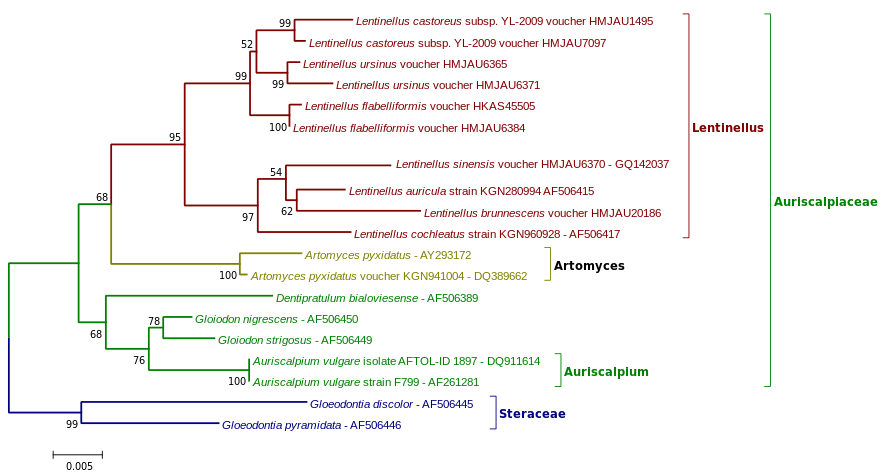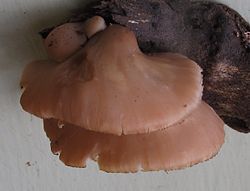Lentinellus Minimum Evolution Tree (28S rRNA-Gene)
Evolutionary relationships of Lentinellus
The evolutionary history was inferred using the Minimum Evolution method on the 28S large subunit ribosomal RNA gene. The optimal tree with the sum of branch length = 0.20698165 is shown. The percentage of replicate trees in which the associated taxa clustered together in the bootstrap test (1000 replicates) are shown next to the branches. The tree is drawn to scale, with branch lengths in the same units as those of the evolutionary distances used to infer the phylogenetic tree. The evolutionary distances were computed using the Maximum Composite Likelihood method and are in the units of the number of base substitutions per site. The ME tree was searched using the Close-Neighbor-Interchange (CNI) algorithm at a search level of 1. The Neighbor-joining algorithm was used to generate the initial tree. The analysis involved 20 nucleotide sequences. All positions containing gaps and missing data were eliminated. There were a total of 871 positions in the final dataset. Evolutionary analyses were conducted in MEGA5. Gloeodontia discolor - AF506445 and Gloeodontia pyramidata - AF506446 were used as outgroup. All sequences were obtained from the Genbank and were aligned by the Muscle algorithm with standard settings.
List of the GenBank Sequences.
- Lentinellus castoreus subsp. YL-2009 voucher HMJAU1495 - GQ219736
- Lentinellus castoreus subsp. YL-2009 voucher HMJAU7097 - GQ219737
- Lentinellus ursinus voucher HMJAU6365 - GQ142028
- Lentinellus ursinus voucher HMJAU6371 - GQ142030
- Lentinellus flabelliformis voucher HKAS45505 - GQ142032
- Lentinellus flabelliformis voucher HMJAU6384 - GQ142035
- Lentinellus sinensis voucher HMJAU6370 - GQ142037
- Lentinellus auricula strain KGN280994 AF506415
- Lentinellus brunnescens voucher HMJAU20186 - GQ142031
- Lentinellus cochleatus strain KGN960928 - AF506417
- Artomyces pyxidatus - AY293172
- Artomyces pyxidatus voucher KGN941004 - DQ389662
- Dentipratulum bialoviesense - AF506389
- Gloiodon nigrescens - AF506450
- Gloiodon strigosus - AF506449
- Auriscalpium vulgare isolate AFTOL-ID 1897 - DQ911614
- Auriscalpium vulgare strain F799 - AF261281
- Auriscalpium vulgare strain F799 - AF261281
- Gloeodontia discolor - AF506445
- Gloeodontia pyramidata - AF506446
Relevante Bilder
Relevante Artikel
ZählingeDie Zählinge (Lentinellus) sind eine Pilzgattung innerhalb der Familie der Ohrlöffelstachelingsverwandten (Auriscalpiaceae). Die Blätterpilze haben nabelig-lappige, zähfleischig bis lederartige und langlebige Fruchtkörper, die einzeln oder büschelig wachsen. Die weißcreme- bis fleischfarbenen Lamellen haben gesägte bis gekerbtrandige Schneiden. Der Stiel steht zentral, exzentrisch oder seitlich. Die Pilze haben amyloide, rau oder feinwarzig ornamentierte Sporen und Gleozystiden. Die saprobiotischen Pilze wachsen auf Holz oder toten Wurzeln. Lentinellus cochleatus P.Karst., der Anis-Zähling, ist die Typusart der Gattung. .. weiterlesen







